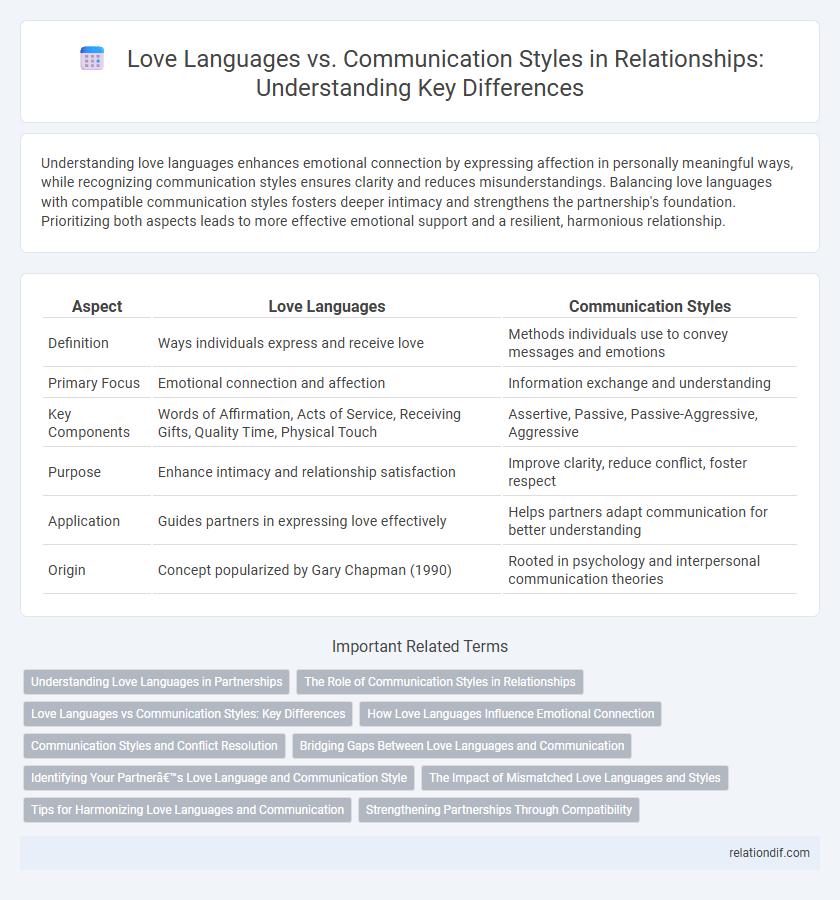Understanding love languages enhances emotional connection by expressing affection in personally meaningful ways, while recognizing communication styles ensures clarity and reduces misunderstandings. Balancing love languages with compatible communication styles fosters deeper intimacy and strengthens the partnership's foundation. Prioritizing both aspects leads to more effective emotional support and a resilient, harmonious relationship.
Table of Comparison
| Aspect | Love Languages | Communication Styles |
|---|---|---|
| Definition | Ways individuals express and receive love | Methods individuals use to convey messages and emotions |
| Primary Focus | Emotional connection and affection | Information exchange and understanding |
| Key Components | Words of Affirmation, Acts of Service, Receiving Gifts, Quality Time, Physical Touch | Assertive, Passive, Passive-Aggressive, Aggressive |
| Purpose | Enhance intimacy and relationship satisfaction | Improve clarity, reduce conflict, foster respect |
| Application | Guides partners in expressing love effectively | Helps partners adapt communication for better understanding |
| Origin | Concept popularized by Gary Chapman (1990) | Rooted in psychology and interpersonal communication theories |
Understanding Love Languages in Partnerships
Understanding love languages in partnerships enhances emotional connection by addressing how each partner expresses and receives affection uniquely. Recognizing primary love languages such as words of affirmation, acts of service, receiving gifts, quality time, and physical touch improves communication and resolves misunderstandings. Tailoring interactions to align with these love languages fosters deeper intimacy and strengthens relationship satisfaction.
The Role of Communication Styles in Relationships
Communication styles significantly impact relationship dynamics by shaping how partners express and interpret love languages. Effective communication fosters emotional understanding, enabling partners to meet each other's needs through gestures, words, and actions aligned with their preferred love languages. Misalignment in communication styles can lead to misunderstandings, reducing emotional intimacy and relationship satisfaction.
Love Languages vs Communication Styles: Key Differences
Love languages describe how individuals express and receive affection, including acts of service, words of affirmation, quality time, physical touch, and receiving gifts. Communication styles refer to how people convey thoughts and emotions, such as passive, assertive, aggressive, or passive-aggressive approaches. Understanding the key differences between love languages and communication styles enhances relationship dynamics by addressing both emotional needs and interaction patterns.
How Love Languages Influence Emotional Connection
Love languages shape how partners express and perceive affection, directly impacting their emotional connection by aligning communication with individual needs. Understanding whether a partner values words of affirmation, acts of service, receiving gifts, quality time, or physical touch helps tailor interactions that deepen intimacy. This alignment reduces misunderstandings, fostering a stronger, more empathetic partnership.
Communication Styles and Conflict Resolution
Communication styles significantly impact conflict resolution within partnerships, shaping how partners express needs and manage disagreements. Understanding individual communication preferences--such as passive, assertive, or aggressive approaches--enables more effective dialogue and reduces misunderstandings. Tailoring conflict resolution strategies to align with each partner's communication style fosters empathy, promotes emotional safety, and enhances relationship resilience.
Bridging Gaps Between Love Languages and Communication
Bridging gaps between love languages and communication styles enhances emotional intimacy by recognizing diverse expressions of affection and understanding. Tailoring conversations to align with a partner's preferred love language, such as words of affirmation or acts of service, fosters clearer connection and diminishes misunderstandings. Cultivating empathy through adaptive communication strategies strengthens partnership resilience and mutual satisfaction.
Identifying Your Partner’s Love Language and Communication Style
Identifying your partner's love language and communication style enhances emotional connection and reduces misunderstandings in a partnership. Understanding whether your partner expresses love through words, acts of service, quality time, physical touch, or receiving gifts helps tailor your approach to meet their emotional needs effectively. Recognizing their preferred communication style--whether direct, reflective, or expressive--ensures clearer dialogues and fosters deeper mutual empathy.
The Impact of Mismatched Love Languages and Styles
Mismatched love languages and communication styles often create misunderstandings, reducing emotional connection and increasing frustration in partnerships. When one partner expresses affection through words of affirmation while the other prefers acts of service, their efforts may go unrecognized or undervalued, weakening relational bonds. Recognizing and adapting to these differences is essential for fostering empathy, improving emotional intimacy, and sustaining long-term relationship satisfaction.
Tips for Harmonizing Love Languages and Communication
Understanding love languages alongside communication styles enhances relationship harmony by ensuring emotional needs are clearly expressed and received. Practicing active listening, validating feelings, and tailoring expressions of affection to a partner's preferred love language fosters deeper connection and reduces misunderstandings. Consistent, empathetic dialogue combined with adapting communication methods strengthens partnership resilience and mutual satisfaction.
Strengthening Partnerships Through Compatibility
Understanding the interplay between love languages and communication styles enhances emotional connection and conflict resolution, strengthening partnerships through compatibility. Recognizing whether a partner expresses affection through words of affirmation, acts of service, or quality time allows for tailored communication strategies that meet each other's needs effectively. Compatibility in these areas fosters deeper empathy and trust, resulting in a resilient and harmonious relationship.
love languages vs communication styles Infographic

 relationdif.com
relationdif.com